Macroevolutionary patterns of salt tolerance in angiosperms (Viewpoint)

doi:10.1093/aob/mcu229
Halophytes are rare, but are widely distributed across angiosperm families. Bromham (pp. 333–341) notes that while salt tolerance can evolve in a wide range of genetic backgrounds, some lineages are more likely to produce halophytes than others. Phylogenetic analyses suggest that enabling traits and cross-tolerances may make these lineages more likely to adapt to increasing salinization, a finding that may prove useful in assessing the likely impact of rapid environmental change on vegetation communities, and in selecting taxa to develop for use in landscape rehabilitation and agriculture.
Geochemical modelling to predict salt- and alkalinity tolerance
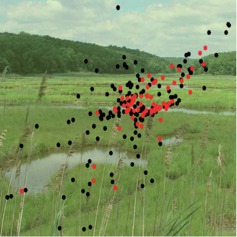
doi:10.1093/aob/mcu248
It has been suggested that tolerance mechanisms and physiological responses to salinity are shared with other types of environmental stresses, such as alkalinity. Saslis-Lagoudakis et al. (pp. 343–351) use extensive occurrence data for Australian grasses together with geochemical modelling to predict values of pH and electrical conductivity to which species are exposed in their natural distributions. They find that genera containing known halophytes have higher predicted salinity conditions than those not containing known halophytes, and that taxa occurring in high predicted salinity tend to also occur in high predicted alkalinity. They conclude that geochemical modelling using species’ occurrence data is thus a potentially useful approach to predict species’ relative natural tolerance to challenging environmental conditions.
Phylogeny, biogeography and diversification of Sarcocornia

doi:10.1093/aob/mcu260
The halophyte genus Sarcocornia is distributed in saline environments throughout the world and shows high diversity in growth form, with a mat-forming habit found in coastal salt marshes of all continents. Steffen et al. (pp. 353–368) construct a dated molecular phylogeny and show that the Sarcocornia (+Salicornia) lineage arose during the Mid-Miocene from a Eurasian ancestor and diversified into four subclades. Sarcocornia diversified in salt-laden environments world-wide, repeatedly evolving the superficially similar prostrate, mat-forming habit, which seems to be advantageous in stressed environments with prolonged flooding, high tidal movement and frost.
Taxonomic complexity in halophytic Limonium

doi:10.1093/aob/mcu186
Halophytic Limonium species are typically found in coastal areas and saline steppes, and harbour significant biodiversity. Cortinhas et al. (pp. 369–383) examine morphological, floral and karyological characters for specimens from Spain and Portugal and find that the resulting discriminant analysis reliably assigns individuals in natural populations to the defined species L. vulgare, L. humile and L. narbonense. In addition, direct evidence is found that L. narbonense and a new species, L. maritimum, related to L. vulgare, are present on Portuguese coasts. It is hypothesized that taxonomic biodiversity found in sites where distinct species co-occur facilitates the evolutionary processes of hybridization, introgression and apomixis.
Regulation of water balance in mangroves (Review)

doi:10.1093/aob/mcu174
Mangroves are a diverse group of woody halophytes and their high water use efficiency under saline conditions suggests that regulation of water transport is a crucial component of their salinity tolerance. Reef and Lovelock (pp. 385–395) review a spectrum of relevant traits that include exclusion of salt during water uptake, maintenance of cellular water potentials lower than those around their roots, structural features that reduce water losses from surfaces, and a capacity to exploit freshwater sources in soils and from the atmosphere. They conclude that while different mangrove tree species vary in their combinations of salt tolerant traits, the capacity to exclude salt from entering the xylem appears to be a critical trait for entering the mangrove habitat.
Hydraulic constraints to growth along a salinity gradient
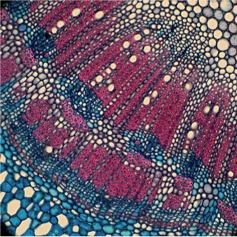
doi:10.1093/aob/mcu257
The mechanisms underlying the characteristic growth enhancement of halophytic eudicots under saline conditions are unknown. Nguyen et al. (pp. 397–407) combine physiological and anatomical analyses to study growth responses of the mangrove Avicennia marina to salinities ranging from fresh- to seawater conditions, and find that seedlings fail to grow in 0–5 % seawater, whilst maximal growth occurs in 50–75 % seawater. Anatomical studies show variation in rates of development and composition of hydraulic tissues that are consistent with salinity-dependent patterns in water use and growth. Specifically, seedlings grown in freshwater are slow to form the second vascular ring and it contains very few xylem vessels compared with those grown with salt, resulting in restricted availability of water to sustain carbon gain and shoot growth under freshwater conditions.
Oxygen and submergence tolerance in stem-succulent halophytes

doi:10.1093/aob/mcu216
Many stem-succulent halophytes experience regular or episodic flooding events, which may compromise gas exchange and reduce survival rates. Konnerup et al. (pp. 409–418) assess submergence tolerance, gas exchange and tissue oxygen status of two stem-succulent halophytes, and find that whereas Tecticornia medusa shows 100 % survival of flooding up to 12 days duration, T. auriculata does not survive beyond 6 days. Surprisingly, O2 profiles and time traces show that, when submerged in darkness, stems of the tolerant T. medusa are severely hypoxic (close to anoxic), whereas stems of the intolerant T. auriculata are only moderately hypoxic. The submergence sensitivity of T. auriculata is associated with swelling and rupturing of the succulent stem tissues, which does not occur in T. medusa.
Cellular basis of salt tolerance in halophytes (Review)

doi:10.1093/aob/mcu217
Halophytes adjust osmotically to soil salinity by accumulating ions and sequestering the vast majority of these in vacuoles, but at high salinities growth is inhibited and Na+ and/or Cl– toxicity is one potential cause. Flowers et al. (pp. 419–431) review the evidence for such toxicity and the concept of tissue tolerance in relation to halophytes. The data suggest that halophytes tolerate cytoplasmic Na+ and Cl– concentrations of 100 to 200 mm, similar to those in chloroplasts, but whether these ions ever reach toxic concentrations that inhibit metabolism in the cytoplasm or cause death is unknown. They conclude that future work should focus on measurements of ion activities in cells and the properties of the tonoplast that enable ion accumulation and prevent leakage from vacuoles.
Diversity and roles of osmolytes in halophytes (Review)

doi:10.1093/aob/mcu239
Osmolytes are low-molecular-weight organic solutes that are accumulated in the cytoplasm of halophytic species, balancing the osmotic potential of Na+ and Cl– accumulated in the vacuoles, and they also have crucial roles such as protecting subcellular structures and scavenging reactive oxygen species. Slama et al. (pp. 433–447) review the diversity of osmolytes among halophytes, their synthesis and distribution within taxonomic groups, the factors that influence their accumulation, and their roles in osmoregulation and osmoprotection. They conclude that engineering of osmolyte accumulation by transgenic technology, in combination with various other traits, represents an important strategy to improve abiotic stress tolerance in crops.
Chloroplastic redox regulation in an extreme halophyte

doi:10.1093/aob/mcu184
Eutrema parvulum (synonym Thellungiella parvula) is an extreme halophyte that thrives in high salt concentrations (100–150 mm) and is closely related to Arabidopsis thaliana. Uzilday et al. (pp. 449–463) measure activities of antioxidant enzymes together with the expression of chloroplastic redox components and genes encoding enzymes of the water–water cycle and proline biosynthesis. The results suggest that efficient induction of activities and expression of water–water cycle enzymes might prevent accumulation of excess reactive oxygen species in chloroplasts and thus protect the photosynthetic machinery. The redox homeostasis in chloroplasts might be achieved by efficient induction of expression of redox regulatory enzymes such as FTR, NTRC, TRXs and PRXs under salinity.
Aldehyde dehydrogenase gene families in Eutrema halophytes

doi:10.1093/aob/mcu152
Aldehyde dehydrogenase enzymes (ALDHs) are considered as ‘aldehyde scavengers’ to eliminate toxic aldehydes that can accumulate under stress conditions. Hou and Bartels (pp. 465–479) perform a genome-wide analysis of ALDHs in two Eutrema halophytes, E. parvulum and E. salsugineum (Brassicaceae), in comparison with the glycophyte Arabidopsis thaliana. They find that genomic organization, gene copy number, sub-cellular localization and expression profiles of ALDH genes are conserved in A. thaliana and the Eutrema halophytes except for differential expression of some stress-associated ALDHs under high salt conditions. This indicates that regulation of transcription may be better adapted to high salt in E. salsugineum than in A. thaliana.
Regulation of H+-ATPase and salinity tolerance in halophytes
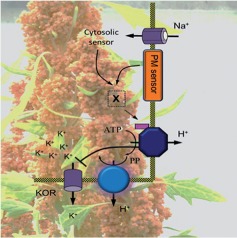
doi:10.1093/aob/mcu219
The activity of H+-ATPase is essential for energizing the plasma membrane (PM) and thus could be important for both potassium retention and sodium exclusion under saline conditions. Bose et al. (pp. 481–494) study the roots of two halophyte species, Atriplex lentiformis and Chenopodium quinoa, and show that enhanced salinity tolerance is not related to the constitutively higher AHA transcript levels in the root epidermis, but to a plant’s ability to rapidly up-regulate the PM H+-ATPase upon salinity treatment. This is necessary for assisting plants in maintaining highly negative membrane potential values and to exclude Na+, or enabling better K+ retention in the cytosol under saline conditions. They conclude that understanding the mechanism of this up-regulation may be instrumental in developing salt-tolerant cultivars by molecular genetics means.
ZxNHX controls Na+ and K+ homeostasis by feedback gene regulation
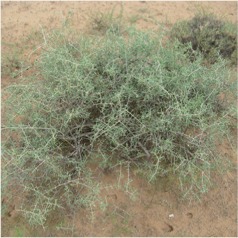
doi:10.1093/aob/mcu177
The xerohalophyte Zygophyllum xanthoxylum efficiently compartmentalizes Na+ into vacuoles mediated by ZxNHX and maintains the stability of K+ in leaves in order to adapt to saline and arid environments. Yuan et al. (pp. 495–507) use post-transcriptional gene silencing to show that ZxNHX is essential for controlling uptake, long-distance transport and homeostasis of Na+ and K+ at the whole-plant level through feedback regulation of the expression of ZxSOS1, ZxHKT1;1, ZxAKT1 and ZxSKOR, which are involved in Na+ and K+ transport. They propose a model for the function of ZxNHX in regulating the Na+ transport system under saline conditions.
Halophyte properties and heavy metal tolerance (Review)

doi:10.1093/aob/mcu264
Halophyte plant species are able to cope with several abiotic constraints occurring simultaneously in their natural environment. Lutts and Lefèvre (pp. 509–528) review their physiological adaptations in relation to high concentrations of bioavailable heavy metals associated with high concentrations of soluble salts, focussing on two types of ecosystem, namely salt marshes and mangroves, and mine tailing in semi-arid areas. They conclude that properties involved in saline tolerance may indirectly contribute to heavy metal tolerance, since heavy metals induce an ionic toxicity, a secondary water stress and an oxidative burst. They discuss the potential use of halophyte plant species for phytoremediation of heavy metals in marginal lands.
The development of halophyte-based agriculture (Review)

doi:10.1093/aob/mcu173
Recruiting wild halophytes with economic potential was suggested several decades ago as a way to reduce the damage caused by salinization of soil and water. Ventura et al. (pp. 529–540) critically review past and present halophyte-based production systems in the context of genetics, physiology, agrotechnical issues and product value. They consider the wide range of cultivation systems for the utilization of halophytes that have been developed, for the production of biofuel, purification of saline effluent in constructed wetlands, landscaping, cultivation of gourmet vegetables and more. They conclude that there is a need for long-term experiments to prove the sustainability of halophyte crop production and their economic prospects for future growers.
Suaeda salsa and the development of saline agriculture (Review)
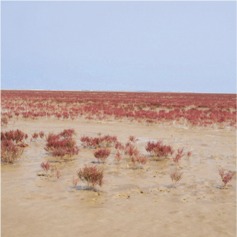
doi:10.1093/aob/mcu194
As important components in saline agriculture, halophytes can help to provide food for a growing world population. Song and Wang (pp. 541–553) consider the euhalophytic herb Suaeda salsa as a promising model for understanding salt tolerance and the development of saline agriculture. For example, the species produces dimorphic seeds, one form of which is salt sensitive whilst the other form can germinate under high salinity, and a series of S. salsa genes related to salt-tolerance have been cloned and their functions tested. The value of S. salsa as a source of food, medicine and forage is discussed, and its uses in the restoration of salinized or contaminated land and as a source of salt-resistance genes are also considered.


